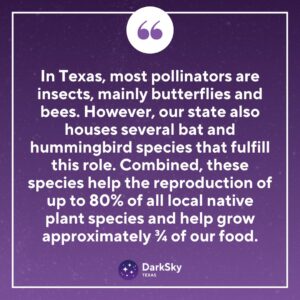Native ecosystems rely on a delicate balance between the plants, animals, and the terrain they live in. Much of this equilibrium happens thanks to the silent, constant work of the smallest animals – the pollinators – ensuring the next generation of flora is ready to bloom in spring.
As a result, any environmental conservation effort needs to take into account the health and happiness of local pollinators. By educating people on light pollution, its types, and its sources, we can also contribute to preserving the natural landscapes of our state. How does light pollution in Texas impact local pollinators and why do we care?
Texan Pollinators – Why Do They Matter?
Pollinators are the “secret laborers” behind many of the world’s ecosystems. While feeding or hunting for water sources, pollinators help carry pollen between and within plants – from a stamen, or “male” part of a plant, to the stigma or “female” part. This makes fertilization possible, bringing forth flowering, and eventually, fruits and seeds.
In Texas, most pollinators are insects, mainly butterflies and bees. However, our state also houses several bat and hummingbird species that fulfill this role. Combined, these species help the reproduction of up to 80% of all local native plant species and help grow approximately ¾ of our food. Thanks to them, we can enjoy the biodiversity in Texas from the Piney Woods in the east through each Texas ecoregion to the Trans-Pecos in the west.
Pollinators Vs. Artificial Lights – What’s the Damage?
Texan pollinator species like the Monarch butterfly face many dangers, threatening their population numbers. In this article, let’s focus on the ones that are directly related to light pollution:
1. Disruption of circadian rhythms

Many pollinators, such as bees and moths, are active at specific times of the day or night. Outdoor lights that do not follow the 5 Principles of Responsible Outdoor Lighting disrupt their natural sleep-wake cycles, “confusing” them and leaving them unable to feed or mate effectively.
2. Disorientation
Many pollinator species like to congregate near night lights – in nature, moonlight and starlight usually emphasize water bodies, which means food. But if these animals chase after unshielded outdoor lights instead, they risk starving.
3. Attracts them to danger
For some species, this love of bright lights goes a step further. Moths and beetles will unerringly chase the brightest light around. This leads them to crash and collide against flood lights, bulbs, or even porch lights – where they can get injured or burnt.
4. Disrupted plant-pollinator interactions
Artificial lights can also affect the life cycles of plants themselves. Landscaping lights or bright LED panels can make the night less dark, mimicking an approaching spring. As a result, plants may flower too soon before enough pollinators are in the area. This makes it harder for plants to bear fruit and bring forth the next generation.
What Can We Do to Preserve Our Local Habitats from Light Pollution?
The secret to curbing light pollution lies in responsible lighting practices. Responsible lighting practices allow people to continue enjoying the safety and warmth of night lights while minimizing their impact on the wider environment.
How? It all starts by thinking about each light fixture before we install it or reviewing ones that are already in place. Is this light necessary? Is this light pointed in the right direction? Can we shield this light to avoid lighting up the sky or bothering our neighbors and nature? Is this light brighter than necessary? Can this light be controlled so that it is only turned on when a person is there to use it? Is this light a warm, amber color? Through smart tweaks, we can keep many of these lights from dispersing in the environment, feeding skyglow, and affecting local pollinator species. At Dark Sky Texas, we are constantly working with landowners and residents to help them find better ways to illuminate their property where needed. With your help, we can continue designing creative solutions that will allow us to live in harmony with the species around us. Join DarkSky Texas today!


